Jumping Into The Unknown: What Next For Rogue Studios?
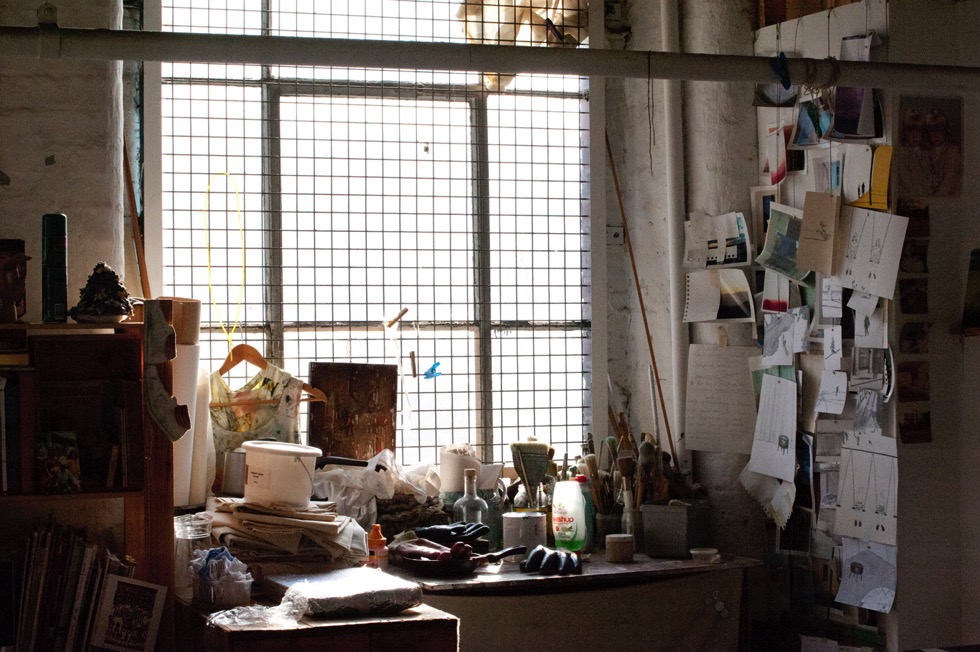
It’s a familiar story of increasing city-centre gentrification. But where does it leave one more arts space facing eviction? Daniel McMillan speaks to the artists of Rogue, Manchester, about paving the way for expensive apartments…
A banner on a graffitied exterior wall, visible to commuters on the Ashton-Eccles tramline, is the only discernible change to Crusader Mill since its change in ownership. The name of property developers Capital & Centric, who purchased the 19th century mill from a private landowner in December 2015, is emblazoned white on black. “Piccadilly there. Live here.” No more information necessary, it seems, to persuade prospective buyers to “call first dibs on a new pad”.
The redevelopment of the building sees the eviction of its current occupiers: five textile companies, and two not-for-profit artists’ studio groups, Rogue Artists Studios and 3rd Floor Studios. Rogue, the largest of the two, has occupied the building since 2000. And while the construction of the “new pads” has not yet started, the end of Rogue’s lease is fast approaching and they have yet to secure new premises. It is uncertain times for the 97 artists in their ranks.
The area surrounding the studios has seen extensive redevelopment work, since the expansion of Manchester Piccadilly rail station in the early 2000s, and with the promise of high speed rail links to London in the early 2030s. What was once wasteland with derelict buildings is now populated by faux-Victorian warehouses, luxury apartments and actual Victorian warehouses converted into luxury flats.
It’s a change David Gledhill, Rogue co-director, has witnessed over the studio’s 15 years in the Ancoats area. “They keep throwing flats up with no infrastructure. There’s no general practitioners, no dentists, no parks… When we moved here this was rubble-strewn scrubland and now it’s totally transformed. It was a red light district and a no-go area.” The building is in close proximity to the Cardroom Estate: a crime-ridden housing estate built in the late 70s, redeveloped and rebranded New Islington in 2002.
Given the recent history of the area, it is unsurprising that Crusader Mill, Grade-II listed and falling into disrepair, has been bought for redevelopment. But while the sale of the building is not particularly noteworthy in itself, the questions it raises regarding Manchester’s changing artistic landscape are.
Rogue was founded in 1995 by Colin Sinclair, a fine art graduate from Manchester School of Art, in collaboration with Diane Harrison Designs, a textile design company working from Hanover Mill. In an event that parallels their current situation, the building was sold to property developers and later demolished, prompting the artists’ studio group to part ways with the textile designer and relocate to their current building.
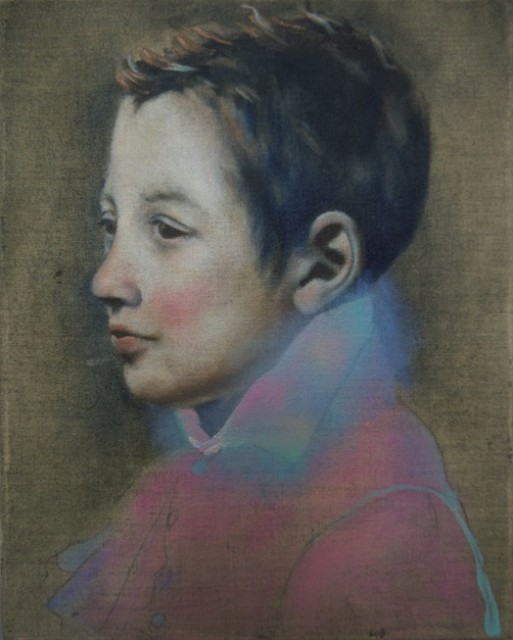
Since then, Rogue has become the largest artist-led studio group in the North, with a mission to provide “affordable, accessible studio space to fine artists in close proximity to city centre amenities”. With the regeneration and expansion of Manchester city centre, it is a mission that is becoming increasingly difficult to fulfil.
I met Hilary Jack, a Rogue member since its early days at Hanover Mill, in her studio space on the first floor. Conversation quickly turns to one of her sculptures: a precarious-looking tower compiled of art books, a step ladder, potted plants, a mouldy fridge and other studio staples (Hell in a Handcart (2016)). It was exhibited in the Rogue project space as part of their Progress exhibition in June, and later described by Bob Dickinson as a “doomed pirate ship” in an article published by a-n.
“I think a lot of the artists are feeling [Rogue’s future] is very uncertain”, says Jack; “and I guess that’s what this structure was meant to say. This teetering thing […] It’s a metaphor for the studio life and also moving from the studios.”
Jack joined Rogue shortly after graduating from a BA in Fine Art at Manchester School of Art in 1995. How has the city changed since then?
“There are many, many more artists now in Manchester”, Jack continues. “I don’t want it to sound like it was the dark ages, but [there has] certainly been a massive change. When I graduated, I think I was basically the only person off the BA that stayed here; everybody else either went to London or Glasgow.”
It would be naïve to suggest that Rogue led this change in Manchester’s artistic landscape, but the role they, and other independent Manchester-born arts organisations — like Castlefield Gallery and The International 3 — have played in nurturing it should not be understated.
Louise Giovanelli (work pictured, above) graduated from Manchester School of Art in 2015 (featuring in TDN’s Class of 2015) and has been a studio member since December. She was quickly picked up by The International 3 and is now one of the gallery’s associate artists. Originally from South Wales, Giovanelli is one of the “many more artists now in Manchester” that Jack mentioned, and continuing to live in the city after graduating. Does she have an opinion on the sale of the building and the relocation of the studios?
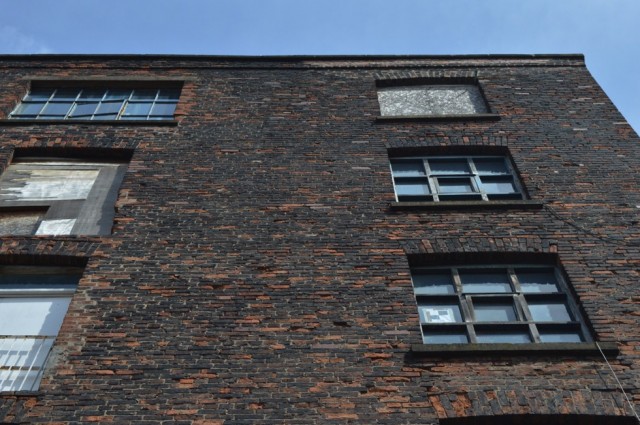
“It seems that artists move into a place, make it cool and desirable”, Giovanelli tells me; “then they get chased out and people want to live in the cool area where the artists are… but [they’re] not there anymore because you’ve chased them out. It’s bizarre.”
The connection between the arts and gentrification is not new. The aforementioned cycle (a community of artists move in to an area of industrial decline, middle class arts consumers follow, creating a market for middle class art consumer amenities thus raising rents and pricing artists out of the area) can be traced back to the 1960s, when artists populated the lofts of New York’s Lower East Side.
The amount of cultural capital that Rogue has brought to the Ancoats area, and the extent to which this has sped up its redevelopment, is difficult to quantify, and the implication that there is equivalence between its fate and that of the NY loft artists, spurious.
A touch of culture, however, is certainly a quality Capital & Centric recognises its target demographic is looking for in the area surrounding their new pad. When describing past redevelopment projects on their website, the company do not talk of building flats or office blocks, but rather “creating communities” and “cultivating cultures”. They also “curate ground-breaking art”.
It’s easy to point out the irony of the situation. To fulfil the Capital & Centric vision of creating a community of cultured pad dwellers for financial gain, they have had to evict a community of artists. Gledhill, however, stresses that the property developers should not be spun as the villains.
“They’re being very co-operative”, says Gledhill. “They’ve funded the website and we’re working with their graphic designer to rebrand the studios [see the flash new Rogue website] … They’re doing as much as they can to compensate us.”
Martin Nash, Rogue co-director, agrees. “Tim Heatley [co-director of Capital & Centric] has devoted a lot of time to us. He has expressed the objective that he wants to make sure that Rogue has a secure long-term future.”
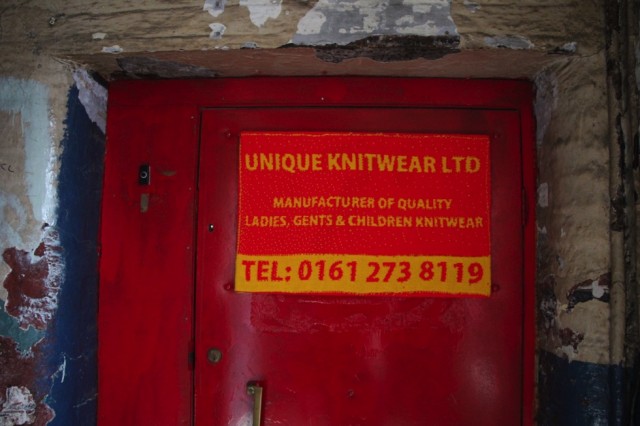
Crusader Mill was built in the 1830s and was originally used to construct machinery for the textile industry. Since then, it has housed multiple knitting factories, depleting in numbers with the demise of Manchester’s textile industry and the purge of traditional industries from the city centre.
The evolution of Crusader Mill is referenced in Rogue artist Sam Meech’s Fait Accompli (2016) – a series of machine knitted tiles currently on display in the main stairwell. The tiles depict areas of the building’s interior walls which were photographed, translated into knitting patterns, machine knitted, and hung over the actual area they depict. Details include the flaking paintwork, hand-painted signage belonging to or left behind by business holders past and present, and coded A4 sheets of paper gaffer-taped to the wall by Capital & Centric’s building surveyors.
The tiles serve as a literal record of the building at the end of its tenure, while the medium calls to mind its history and the presence of the knitting factories that still occupy it. For Meech, however, this was not a conscious reference. They are the result of his continued interest in machine knitting and its connection to analogue film. Driven by the news that the building had been sold to property developers, he arranged a residency with Crusader Knitwear: one of the knitting companies that shares the space. I ask him what problems the business is facing following the sale of the building?
“They’ve got these massive machines” Meech says, “and they’ve got about 20 of them, and they’ll have to get them out with a crane. It’s going to cost them 15-20 grand just to move once they’ve found somewhere. They’re facing this question of: Should we just pack it in?”
What has the relationship between the artists and knitting companies been like generally?
“They all interact with each other”, Meech tells me. “The technicians will move between businesses. The knitting businesses and artists, there’s no reason why we’d do anything together. But we’re all in the same boat.”
Much of what makes Rogue unique — that it is self-governed, not for profit, and has low levels of bureaucracy — has no doubt played a part in their building being bought from under them. Is it therefore possible for the organisation to exist in its current form?
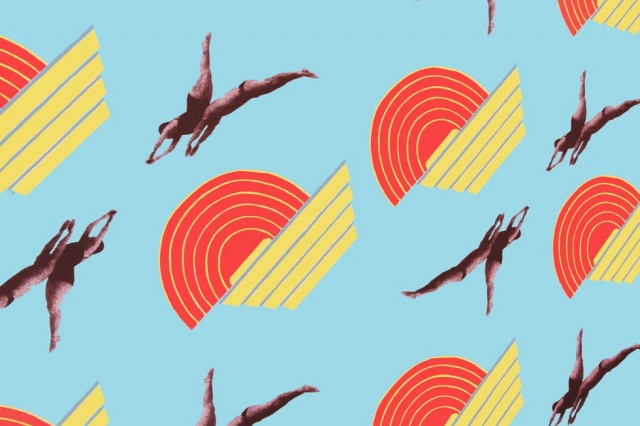
Though Manchester city centre rent prices have increased significantly since the studio group was first established in the ‘90s, there are still models that Rogue can look to that would enable them to continue to provide affordable studio space. Examples include Castlefield Gallery’s New Art Spaces scheme, through which deals are negotiated with property developers and landlords to allow artists access to vacant spaces in the North West, and NY Space, a project space set up in the city centre in collaboration with Bruntwood.
These collaborations are proof that third parties are receptive to the idea of hosting cultural activity, but they are generally short-term, and artists are on the back foot of the deal – having to vacate once their creative ‘purpose’ in the building has been served.
Gledhill states that Rogue are in conversations with the Arts Council and Manchester and Salford City Councils to secure a new property. Speaking of the connection between the arts and redevelopment, he remarked: “I think it’s time artists understood that their strength lies in their economic clout with the Council. If we can get them to use us to regenerate neglected areas, and if they’re providing the affordable buildings, we can get something out of that. We can claim some of the value that we create.”
Exactly which route Rogue chooses to go down in securing a new property, and whether they can broker a deal that ensures longevity for the studio group, remains to be seen.
Daniel McMillan
This article has been commissioned by the Contemporary Visual Arts Network North-West (CVAN NW), as part of a regional critical writing development programme funded by Arts Council England — see more here #writecritical
Read the programme’s book, On Being Curious: New Critical Writing on Contemporary Art From the North-West of England; available as a free e-book HERE (yes, free of charge!)
Images, from top: Rogue Artist Studios: interior, courtesy Jan Chlebik. Louise Giovanelli, The Dress rehearsal II’ – Oil on linen, 2016. Rogue Artist Studios: exterior, courtesy Rogue artist David Gledhill. Rogue residency artist Sam Meech, Unique Knitwear 2016. Rogue artist Jenny Steele, Over and Over, Jump In!





